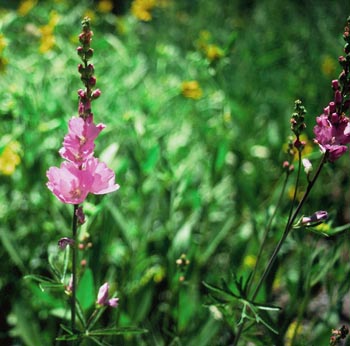Oregon Checkermallow

Common Name(s):
Oregon Checkermallow
Oregon Checkerbloom
Oregon Checker
Scientific Name:
Sidalcea oregana (Nutt. ex Torr. & Gray) Gray.
Scientific Name Synonyms:
None Known
Symbol:
SIOR
Description:
Life Span: Perennial
Origin: Native
Growth Characteristics: A showy perennial growing up to 3 feet tall. It has a branched rootcrown above a taproot. It flowers from the end of June until the middle of August and fruit is set in late August.
Flowers/Inflorescence: Short-stalked, pale lavender to pink colored flowers are borne in a terminal spike. Some flowers are bisexual, while in others, the anthers are sterile or lacking. It has a 5-lobed, hairy calyx and 5 separate, oblong, shallowly bilobed petals that are 15-20 mm long. Numerous stamens are united into a tube surrounding the style. The many stigmas are linear.
Fruits/Seeds: Fruit is 2-3 mm long and is a flattened round capsule with many sections, giving it the appearance of a peeled orange. Seeds have a honeycomb pattern.
Leaves: Basal leaves have long petioles and round blades that are deeply palmately divided into 5-9 nearly linear lobed sections. The alternate stem leaves become smaller with few lobes upward. The lower leaves are covered with star-shaped hairs.
Stems: Erect, 10-80 inches tall, with the lower stems covered with star-shaped hairs.
Roots: A taproot, rarely with rhizomes.
Ecological Adaptions:
Oregon checkermallow grows best in full sun, but is not drought tolerant. It is often found in meadows, sagebrush plains, and open ponderosa pine forests. In Utah, it occurs as far south as Sevier County, and is most prevalent along the Wasatch Mountains.
Soils: Prefers moist soils
Associated Species: Big sagebrush, American bistort, Tall Larkspur
Uses and Management:
Oregon Checkermallow is often admired for its showy flowers.

